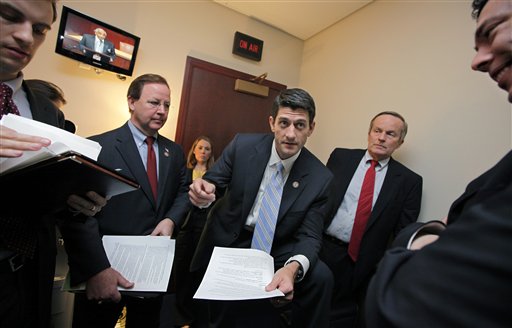This week, many Americans are getting their first look at Rep. Paul Ryan, Mitt Romney’s choice to be the nation’s vice president. Despite two years as the House Republicans’ point man on budget matters, according to polls, only half of the country knows who Ryan is.
The Romney campaign will take advantage of his first days on the national stage to promote the qualities they believe he will bring to the ticket, such as his obvious intelligence and deep knowledge of how the government works, along with his civil demeanor, youth, good looks and attractive family.
But voters will have more than those images to pore over in the two-plus months before Election Day. Unlike Romney, Ryan has a legislative record that shows where he would guide the country, and it fills in gaps in Romney’s agenda that his campaign has so far left blank. The most telling is the so-called Ryan budget, which under his leadership has twice passed the U.S. House of Representatives.
What it tells about Ryan is that he is not, as some headlines claim, a “deficit hawk.” Ryan’s budget would dramatically cut spending, both to entitlements and other non-defense federal programs, but also calls for steep tax cuts, far in excess of the Bush tax cuts — which it would make permanent — and even Romney’s tax proposals. (According to some calculations, if the Ryan plan were law, a man like Romney who earns more than $20 million a year in capital gains and other investment income would pay no federal income tax at all.)
According to projections by the Congressional Budget Office, which crunched the numbers Ryan provided using rules that Ryan wrote, the federal budget would not come into balance for 30 years.
Instead of a deficit cutter, Ryan is a government reformer who fits the dictionary definition of radical (“from the roots”).
Most famously, Ryan would redesign Medicare to save money by increasing the age of eligibility for future retirees and turning it into a voucher program in which participants would buy their own private insurance and take responsibility for any costs above what the government chit would cover.
But what he would do to non-entitlement spending could have even greater impact.
In the name of giving states more flexibility, he would cut back on federal money for Medicaid, education and other programs. The shift would mean that state governments would be forced to choose between cuts of their own or tax increases. The cascading resource shortages from the federal to the state and local levels would fundamentally change the size and scope of government.
Ryan, of course, would not be able to accomplish any of that as vice president, but his selection as Romney’s running mate puts his vision for America on the table as the alternative to four more years of the Obama administration.
As Americans get to know this plan and its author, they will get a much clearer picture of Romney and what his first important appointment tells us about where he proposes to lead the country.
Send questions/comments to the editors.



Success. Please wait for the page to reload. If the page does not reload within 5 seconds, please refresh the page.
Enter your email and password to access comments.
Hi, to comment on stories you must . This profile is in addition to your subscription and website login.
Already have a commenting profile? .
Invalid username/password.
Please check your email to confirm and complete your registration.
Only subscribers are eligible to post comments. Please subscribe or login first for digital access. Here’s why.
Use the form below to reset your password. When you've submitted your account email, we will send an email with a reset code.